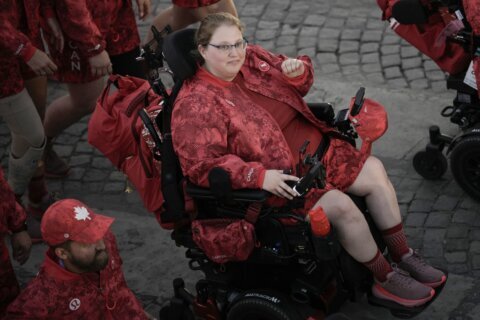PARIS (AP) — Before 2012, Matt Stutzman couldn’t get a job. Then, he became a Paralympian.
It changed his life for the better, as it has for other veterans of the Games. But he, like other athletes who have experienced the growth of the Paralympics, still think it will take years more of promotion and hard work by athletes with disabilities to get something like equal footing with able-bodied athletes.
“People would see that I had no arms, and they just wouldn’t give me the chance to prove that I could work,” Stutzman, the compound open archer, says in an interview at Team USA House. “They literally would be like, ‘If you had prosthetic arms, I would hire you.’ and I was like ‘What?’”
It’s not an unusual story. In interviews with more than a half-dozen longtime Paralympians this week, they all noted that, as much as they want to see greater acceptance of disabled athletes, it still has come a long way.
America’s most decorated wheelchair racer, Tatyana McFadden, experienced a very different scene from Paris when she debuted in Athens in 2004. She and her teammates didn’t even have matching uniforms, she recalled.
“When I tell the young ones, I’m like, ‘So many people before you paved the way so you can all have the same kits!’” she said. “So, yeah, it’s changed for the better.’”
Several veteran para-athletes reflected on stories told by their predecessors about how, during the 1996 Atlanta Paralympics, they could count the fans in the stands. Crowds started arriving in London, the Paralympics that holds the record for ticket sales at 2.7 million. In Rio de Janeiro, fans could use an app to purchase tickets, while in Paris, venues are reaching near capacity and crowds are enthusiastic.
“It didn’t kind of have the credibility that it has now,” says Aaron Phipps, who’s been a member of Britain’s wheelchair rugby team since 2012.
Altering perception
The Paralympic movement isn’t limited to the Games played every four years. It’s also about educating people around the world regarding what it means to live with a disability. It varies depending on the person, but experienced Paralympians often see themselves as advocates as well as athletes.
Sports like wheelchair rugby, where players crash into one another, sometimes shocks those new to the Paralympic scene. But there’s nothing to be afraid of, Phipps says, Paralympians don’t want to be viewed differently. Once that shock disappears, disability becomes normalized.
The growth of social media has only helped. The Paralympics TikTok account has nearly five million followers — going viral is getting people interested and curious.
Veterans say there’s less staring at them on the streets of Paris than in previous host cities, yet lingering skepticism about what these athletes are capable of remains.
The same venues are used for the Olympics and Paralympics, including the triathlon route. On Monday, the Seine’s current was strong, and Lauren Steadman — a British veteran who competed in her first Paralympics in Beijing in 2008 and won bronze in the PTS5 class for people with an issue in both forearms along with leg and ankle impairments — had no doubt every competitor was equipped to handle the conditions.
“Many would’ve been like, ‘You’re doing that to Paralympians? You’re putting them on a tough course?’ Actually, yeah. We don’t need it to be easier,” Steadman says. “You’re just asking us to find a way and we did.”
Meanwhile, for events and media interviews, Team USA House is open for Paralympians just as it was for Olympians.
Gender disparity
Like McFadden, swimming star Jessica Long’s first Paralympics was the 2004 Athens Games. Together, they were two of 1,149 females competing, representing just over 30% of all athletes.
Women make up 45% in Paris, and the U.S. veterans are two of nearly 2,000.
Scout Bassett, who competed in Rio and is the president of the Women’s Sports Foundation, says the lower percentage of female athletes in para sports links to how women with disabilities are presented in mainstream media and entertainment.
“The disability becomes the deficiency, the imperfection, because she doesn’t measure up to the ideal version of what a beautiful woman is,” Bassett says at Team Great Britain’s House during an event hosted by CitiBank.
Bassett created a fund that’s dedicated to investing in female athletes. Grant recipients Jaleen Roberts and Julia Gaffney have already medaled in Paris.
Growing para sports for women sometimes fall on the veterans. They’re the ones up-and-coming para stars are looking to.
“I don’t want to be inspirational for going to the grocery store or putting on my shoes,” Long says. “If you can be inspired by my true talent in the pool and if you understand what I’m doing to navigate my body, then I think that is amazing, right?”
Long later won the S8 400-meter freestyle for swimmers with the absence of limbs for her 30th overall medal and 17th gold.
Platform with a purpose
While medals are what they compete for, many Paralympians strive to leave a legacy of impact. They’ve witnessed what the Games were, are experiencing how it is now, and have visions for what they want it to become.
“If you don’t use your platforms, it’s going to stop with you,” Stutzman says. And if the next athletes “don’t do what I did, as far as just promoting and pushing and inspiring the world, we’re gonna go steps backwards.”
—-
Amanda Vogt is a student in the John Curley Center for Sports Journalism at Penn State.
—
AP Paralympics: https://apnews.com/hub/paralympic-games
Copyright © 2024 The Associated Press. All rights reserved. This material may not be published, broadcast, written or redistributed.






